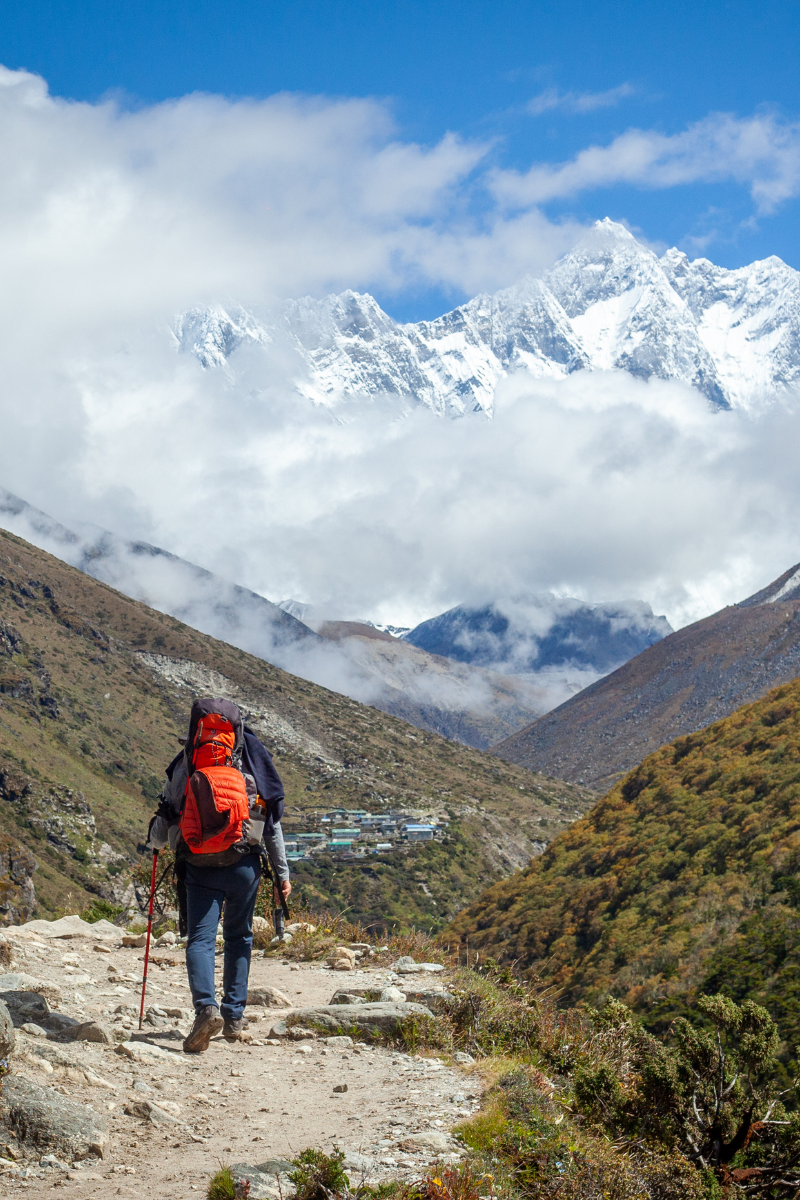Standing at Everest Base Camp, with the world’s tallest mountain looming overhead, is like staring at a giant that’s equal parts awe-inspiring and humbling.
The view of Mount Everest from base camp isn’t just a photo op—it’s a reward for grit, determination, and surviving the occasional questionable bathroom setup. Whether you’re here for the Everest base camp photos or the bragging rights, this journey will stick with you long after your boots dry out.
Let’s break down why this view is legendary, how to survive the trek, and what makes it all worth it—even when your legs threaten mutiny.
First rule of Everest Base Camp: Patience pays off
Here’s a secret no one tells you: Mount Everest hides like a shy celebrity during much of the trek. Your first real glimpse often comes not at base camp, but from a windswept ridge near Namche Bazaar, the bustling Sherpa hub at 3,440 meters (11,286 ft). It’s a tease—a distant, snow-capped peak that whispers, “Keep going, I’m worth it.”
When you finally arrive at Everest Base Camp (5,364 meters/17,598 ft), the mountain reveals itself in full glory. The Khumbu Icefall tumbles below the summit like a frozen waterfall, while neighboring giants like Ama Dablam—nicknamed the “Matterhorn of the Himalayas”—stand guard.
Pro tip: Sunrise is prime time for Everest base camp pictures. The peak glows pink, and the blue sky backdrop makes even amateur photographers look like pros.
How to survive (and thrive) on the trek to Mount Everest
Let’s be honest: The trek to Mount Everest isn’t a leisurely stroll. It’s a high-altitude marathon where the air gets thinner and the trails get steeper. Here’s how to avoid becoming a cautionary tale:
Your survival kit
Acclimatise like a pro
Spend two nights in Namche Bazaar. Your lungs will thank you when you’re not gasping for air at Gorak Shep, the last village before base camp.
Layer up or freeze
Temperatures swing from Sahara-hot to Arctic-chill faster than you can say “Khumbu Valley.” Pack moisture-wicking base layers and a down jacket.
Snack like a Sherpa
Snickers bars are gold on the trail. They’re calorie-dense, morale-boosting, and perfect for bribing your tired legs to keep moving.
The unofficial rules of the trail
1. Embrace the “Almost There” lie
Guides will claim it’s “just 20 more minutes!” for hours. Smile, nod, and keep walking.
2. Respect the prayer flags
Those colorful flags fluttering in the wind? They’re sacred markers—don’t touch them, but do snap a few images of Mt Everest base camp with them in the frame.
3. Master the squat
Let’s just say the toilet facilities are… rustic. Practice your deep-knee bends beforehand.
When should you visit Everest Base Camp?
The time of year you choose to trek to Everest Base Camp can completely shape your experience.
Want clear mountain views? Comfortable temperatures? Fewer people on the trails? Every season has something different to offer, so here’s what to expect.
Spring (March through May)
One of the best times to visit. The skies are mostly clear, the temperatures are nice, and the trails are popular with hikers. Base Camp is also a focus of activity for Everest summit efforts. The only drawback? You will not be alone, as this is one of the most popular trekking seasons.
Summer (June-August)
The monsoon season brings torrential rain, muddy pathways, and cloud-covered peaks. The views of Everest are frequently obscured, and flights to Lukla are unpredictable due to bad weather. What's the upside? There are fewer hikers, so you will have more of the trail to yourself.
Autumn (September to November)
Another peak season for good reason. The monsoon rains clear away the dust, leaving behind crisp air and stunning mountain views. Like spring, this is a busy time, so expect to share the route with plenty of fellow adventurers.
Winter (December to February)
The skies are often clear, but temperatures can drop well below freezing, and snowfall can make parts of the trail treacherous. On the plus side, you’ll have a quieter, more peaceful experience with fewer people on the trails.
For more information on the best mix of great weather, stunning views, and manageable trekking conditions, click here.
Why the view of Everest is more than just a photo
A story in stone and ice
The view of Mount Everest from base camp isn’t just a pretty backdrop. It’s a front-row seat to geological drama. The mountain’s sheer scale—8,848 meters (29,029 ft) of rock and ice—puts human ambition into perspective. Climbers have summited it, died on it, and revered it for centuries. Standing there, you’re part of that story.
The hidden gems you’ll miss in photos
Sagarmatha National Park
This UNESCO World Heritage Site isn’t just Everest’s playground. Keep an eye out for Himalayan thars (mountain goats with better balance than a yoga instructor) and pheasants darting through rhododendron forests.
The Khumbu Valley’s Atmosphere
Picture alpine meadows dotted with stone-walled teahouses, the smell of garlic soup simmering over a stove, and the sound of yak bells clinking in the distance. It’s equal parts rugged and serene.
Beyond Base Camp: Adventures for the Bold
If the classic trek to Mount Everest feels too mainstream, try these upgrades:
1. Gokyo Lakes: Where the water defies logic
Swap the crowded EBC trail for the Gokyo Valley’s turquoise lakes. The reflection of Cho Oyu, the world’s sixth-highest peak, on the water is straight out of a fantasy novel. Our EBC and Gokyo Lakes trek.
2. Three Passes: For the glory (and the pain)
Kongma La, Cho La, and Renjo La—three passes over 5,300 meters—separate the casual hikers from the hardcore. The views? Unreal. The effort? Let’s just say you’ll sleep like a rock afterward. Explore our EBC and Three Passes trek.
3. The Classic EBC Trek
Short on time? This Classic EBC Trek delivers the view of Everest without skimping on Sherpa culture or Himalayan panoramas.
Your Everest Base Camp FAQ (No sugarcoating)
“Will I get altitude sickness?
Maybe. Symptoms range from headaches to nausea. Hydrate relentlessly, walk slowly, and consider Diamox (ask your doctor). For a full packing guide, check our Everest Base Camp packing list.
“Can I charge my phone?”
Yes, but teahouses charge by the hour. Bring a solar charger—and don’t forget extra memory cards for all those Mount Everest base camp photos.
“Is it safe?”
Yes, with a reputable guide. The Khumbu region’s trails are well-marked, but weather and altitude are wild cards.
Ready to earn that view?
The trek to Mount Everest isn’t just about the destination. It’s about the camaraderie of shared Snickers bars, the quiet triumph of reaching Gorak Shep, and the moment you realise the view of Everest isn’t just a mountain—it’s a mirror reflecting your own resilience.
So, lace up your boots, pack your sense of humor, and dive into the chaos. For more tips, routes, and inspiration, explore our Everest Base Camp guides or browse adventure trips tailored to every ambition.
When you finally see Everest, take a breath before reaching for your camera. Some moments are meant to be felt, not just filtered.






